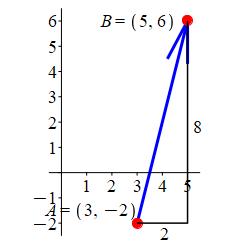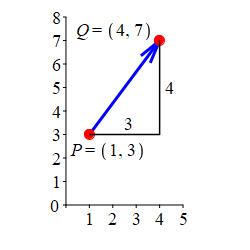5. Vectors
a. Definition, Magnitude and Direction
2. Displacements
Vectors are often drawn between two points in order to show a change of position or displacement. In particular, if something moves from point \(P=(p_1,p_2)\) to a point \(Q=(q_1,q_2)\), this change in position is commonly denoted by the displacement vector: \[ \overrightarrow{PQ}=Q-P=\left\langle q_1-p_1,q_2-p_2\right\rangle \] Here, \(P\) is the tail of the vector while \(Q\) is the tip of the vector.
Suppose you trace a line segment which starts at the point \(A=(3,-2)\) and ends at the point \(B=(5,6)\). What displacement vector describes this motion?
Subtract the coordinates of the initial position from those of the final position. The resulting displacement vector is \[ \overrightarrow{AB}=B-A=(5,6)-(3,-2)=\left\langle2,8\right\rangle \] The picture gives a graphical representation of this vector.

Find the displacement vector from \(P=(1,3)\) to \(Q=(4,7)\). Plot it.
\(\overrightarrow{PQ}=\left\langle3,4\right\rangle\)

The displacement vector is: \[ \overrightarrow{PQ}=Q-P=(4,7)-(1,3) =\left\langle3,4\right\rangle \] We plot the points \(P=(1,3)\) and \(Q=(4,7)\) and connect the dots.

Heading
Placeholder text: Lorem ipsum Lorem ipsum Lorem ipsum Lorem ipsum Lorem ipsum Lorem ipsum Lorem ipsum Lorem ipsum Lorem ipsum Lorem ipsum Lorem ipsum Lorem ipsum Lorem ipsum Lorem ipsum Lorem ipsum Lorem ipsum Lorem ipsum Lorem ipsum Lorem ipsum Lorem ipsum Lorem ipsum Lorem ipsum Lorem ipsum Lorem ipsum Lorem ipsum